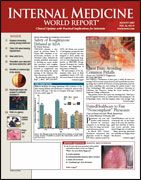Publication
Article
Internal Medicine World Report
How to Reduce Warfarin-Induced Intracerebral Hemorrhage Risk
Author(s):
By Wayne Kuznar
SAN FRANCISCO—Factors that increase the risk for intracerebral hemorrhage while taking warfarin (Coumadin) are often modifiable, said Brian F. Gage, MD, MSc, at the American Heart Association's International Stroke Conference.
Risks for intracerebral hemorrhage include age, male gender, hypertension, high alcohol intake, current smoking, and diabetes, according to a systematic review (Stroke. 2003;34:2060-2065). Additional risk factors are bleeding diathesis; antithrombotic therapy, including aspirin; liver and renal disease; central nervous system abnormalities, such as metastases, leukoaraiosis, and abnormal vasculature; and trauma.
Risk factors specific to warfarin use include noncompliance, susceptibility to falls, supratherapeutic international normalized ratio (INR) values, and genetic polymorphisms that affect warfarin metabolism or susceptibility.
Risk for intracerebral hemorrhage rises with an INR >4. In contrast, when INR falls to <2, risk for ischemic stroke increases. In the European Atrial Fibrillation Trial (N Engl J Med. 1995;333:5-10), a significantly increased risk of major bleeding was observed in patients who took warfarin and had an INR >3.5, and an increase in the risk of ischemic events was seen in patients with an INR <2.
In the SPIRIT trial (Ann Neurol. 1997;42:857-865), in which patients with cerebral ischemia of arterial origin received aspirin or high-dose anticoagulant therapy, the risk of major bleeding was 8-fold greater in patients with a high INR.
To assess whether or not to anticoagulate patients who are prone to falls, Dr Gage presented data from his own 2005 study of 20,000 Medicare beneficiaries with atrial fibrillation, 1245 of whom were judged to be at high risk of falling (Am J Med. 2005;118:612-617).
The rate of traumatic intracerebral hemorrhage was very high among patients deemed to be at high risk of falling, whereas the rate in other patients was modest. Anticoagulation can still be used in patients who fall, "provided the risk for stroke is sufficiently high that there is a benefit," said Dr Gage, associate professor of medicine at Washington University in St. Louis, MO.
His group quantified this using a hazard ratio of warfarin for a composite outcome—out-of-hospital death or hospitalization for stroke, myocardial infarction, or hemorrhage. The patients' risk for stroke was calculated using the CHADS criteria of 1 point for any of these:
- Congestive heart failure
- Hypertension
- Age >75 years
- Diabetes
- And 2 points for previous Stroke or transient ischemic attack.
Scores <2 were considered low risk for stroke. Patients with a moderate-to-high risk for stroke had a 25% reduction in relative risk for the composite end point. "Patients with low risk for stroke had no benefit, and we recommend that they take aspirin or no antithrombotic therapy," he said.
Genetic Predisposition
CYP2C9
For warfarin therapy, there are genetic predictors of adverse events, Dr Gage said. Patients who metabolize warfarin poorly because of a variant in the gene will have an accumulation and prolonged half-life of the drug. These patients take longer to achieve a stable dose. Disturbingly, these patients have an increased risk for shorter time to first serious or life-threatening bleed, Dr Gage warned.
VKORC1
The vitamin K epoxide reductase (VKOR) enzyme is critical to the vitamin K cycle, upon which warfarin exerts its effects. Patients with the haplotype have a lower production of VKOR, their vitamin K cycle is less efficient, and they have lower warfarin requirements. Dr Gage and colleagues postulate that taking these genetic variants into account, along with clinical factors, can allow one to predict an optimal warfarin dose.
CYP2CO
In a retrospective stepwise regression analysis of 1015 patients, his group found that the most important predictors of warfarin dose were VKOR, body surface area, variants, age, and target INR. His group has constructed a dosing algorithm, available at www.warfarindosing.org, in which key clinical variables can be entered to get an estimated optimal dose of warfarin. "This approach won't replace INR monitoring, but it may improve the time in the target range, and I assert it will most likely decrease adverse events in patients in whom we're starting warfarin therapy," Dr Gage said.





